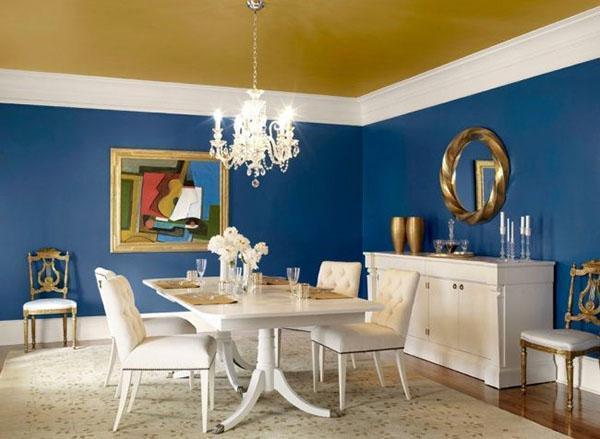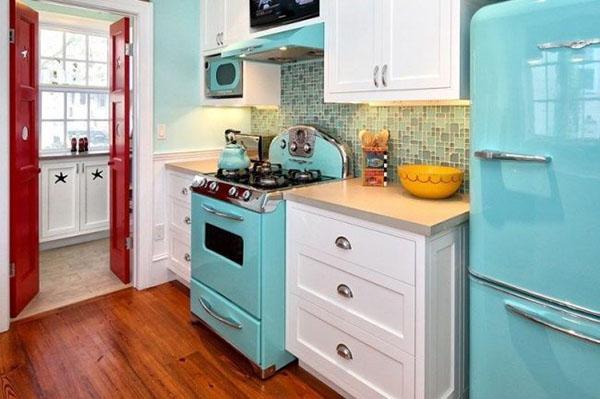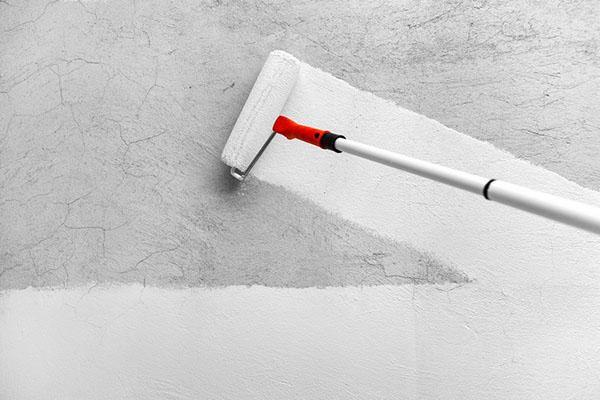High-quality painting of walls in the kitchen
 There is a high probability that stains from greasy sauces, juice or other nature will appear on the walls of the kitchen. To get rid of them easier, painting the walls in the kitchen should be carried out with detergents that are resistant to washing. These paints are water-based and therefore practically odorless. They are made on the basis of acrylic or latex compounds. When applied to walls, they form an impenetrable film on surfaces and do not deteriorate when stains are removed from them.
There is a high probability that stains from greasy sauces, juice or other nature will appear on the walls of the kitchen. To get rid of them easier, painting the walls in the kitchen should be carried out with detergents that are resistant to washing. These paints are water-based and therefore practically odorless. They are made on the basis of acrylic or latex compounds. When applied to walls, they form an impenetrable film on surfaces and do not deteriorate when stains are removed from them.
Features of permanent paints

 It may be easier to choose which paint to paint the walls in the kitchen, given that it is easier to wash stains from a glossy or semi-gloss surface. With matte, this is more difficult to do, since dirt particles penetrate into the porous structure of such a coating.
It may be easier to choose which paint to paint the walls in the kitchen, given that it is easier to wash stains from a glossy or semi-gloss surface. With matte, this is more difficult to do, since dirt particles penetrate into the porous structure of such a coating.
In places with a high potential for contamination, it is better to use paints with glossy properties.
Preliminary preparation
 Acrylic, latex and acrylate paints have increased hiding power, which allows you to hide minor defects. But usually preliminary preparation of the wall for painting in the kitchen is necessary. They are plastering, puttying and grinding, resulting in a solid and even surface.
Acrylic, latex and acrylate paints have increased hiding power, which allows you to hide minor defects. But usually preliminary preparation of the wall for painting in the kitchen is necessary. They are plastering, puttying and grinding, resulting in a solid and even surface.
Using the spider web
 The reliability of the coating is added by pasting with fiberglass "cobweb" for the starting treatment (a kind of reinforcement). Then they are processed with a finishing putty. It is possible to identify errors using a lamp with LED lighting.
The reliability of the coating is added by pasting with fiberglass "cobweb" for the starting treatment (a kind of reinforcement). Then they are processed with a finishing putty. It is possible to identify errors using a lamp with LED lighting.
When painting the walls with glossy paint, a perfectly even coating is necessary, since gloss visually increases even minor errors.
Padding
 The last step in preparing surfaces for painting is priming. Such a tool is selected for the type of paint (acrylic or latex). Priming reduces the absorbency of the substrate, which will save on paint costs and achieve a perfect and uniform coverage.
The last step in preparing surfaces for painting is priming. Such a tool is selected for the type of paint (acrylic or latex). Priming reduces the absorbency of the substrate, which will save on paint costs and achieve a perfect and uniform coverage.
It is recommended to use the primer even if the walls have a surface with a relief pattern, for example, in the form of brickwork. The paint on such a surface will be easier to apply, hold tight, and will not flake off.
Wall color matching
 It is difficult to finally decide on the color of the walls. Some firms offer to create a certain shade on special equipment (about 200 options). In addition, it is possible to give them a metallic shade or add shine.
It is difficult to finally decide on the color of the walls. Some firms offer to create a certain shade on special equipment (about 200 options). In addition, it is possible to give them a metallic shade or add shine.
Ornament
 In the kitchen, you can also apply an ornament in the form of stripes, geometric shapes or patterns, decorate with painting or in another way from a large number of different options. But first, the main color of the walls in the kitchen must be chosen.
In the kitchen, you can also apply an ornament in the form of stripes, geometric shapes or patterns, decorate with painting or in another way from a large number of different options. But first, the main color of the walls in the kitchen must be chosen.
There are two approaches to choosing a dominant shade:
- Choose a bright paint. At the same time, the kitchen set can be in harmony with the walls, or be contrasting.
- Paint the walls with a neutral background shade. This will create a calm atmosphere. Such a wall painting design in the kitchen can take on dynamism from bright furniture or accessories.
When choosing a shade, you must, first of all, remember about its effect on the emotional state:
- It is difficult and tiring to be in a red room for a long time.It is better to choose orange, which is more delicate in its action.

- Shades of green are needed for a relaxing effect. For variety and to give some liveliness, yellow elements are added to them.

- Brown will give stability to the interior, but its too dark shade will create a very gloomy atmosphere.

- Black is best used as a supplement for painting small areas so that it does not overwhelm, but makes the interior more dynamic.

If there is no particular preference in choosing a color, then it is better to choose options for painting walls in the kitchen from neutral paints: gray, beige or white. They do not overload the interior, they go well with picturesque furniture facades kitchen sets.
Painting the walls in the kitchen
 Painting the walls in the kitchen with your own hands saves the family budget. The process of applying paint is determined, first of all, by its type, as well as depending on the substrate used.
Painting the walls in the kitchen with your own hands saves the family budget. The process of applying paint is determined, first of all, by its type, as well as depending on the substrate used.
Before starting work, take out all furniture, remove skirting boards and door trims. The entire surface that may be stained is covered with foil (floor, windows, doors, apron near kitchen furniture). It is glued with adhesive tape with a double-sided adhesive surface. For the floor, use unnecessary newspapers, old wallpaper.
Painting process
 The paint is applied with rollers or with a soft bristled brush. For uniform staining, at least two layers are required. They are applied only after the previous one has completely dried. The time of this period is indicated in the instructions. To apply evenly, use a roller with a small amount of paint. This is best done using a special tray.
The paint is applied with rollers or with a soft bristled brush. For uniform staining, at least two layers are required. They are applied only after the previous one has completely dried. The time of this period is indicated in the instructions. To apply evenly, use a roller with a small amount of paint. This is best done using a special tray.
Number of layers
 The mistake of many is that they try to paint everything with only one layer. But the thicker the layer, the more likely it is to smudge. In this case, you will have to wait until it dries completely, and then clean them off with sandpaper.
The mistake of many is that they try to paint everything with only one layer. But the thicker the layer, the more likely it is to smudge. In this case, you will have to wait until it dries completely, and then clean them off with sandpaper.
 It is important to apply the first layer thinly and then another on top. Even using a roller, it is necessary to paint with a brush the places at the joints of the ceiling with the wall, corners.
It is important to apply the first layer thinly and then another on top. Even using a roller, it is necessary to paint with a brush the places at the joints of the ceiling with the wall, corners.
To get a beautiful coating, the first layer is applied with a roller in the horizontal direction, and the second in the vertical direction.
Drying time
After drying, the painted wall should not be immediately tested for washable. Some coatings gain their performance only after 30 days. Therefore, you need to carefully read the instructions.
Various options
 If it is difficult to choose which color to paint the walls, then you can use this direction of painting - use several at the same time. Companions are selected: dark and light shades of the same color, contrasting or combined. It is popular to paint the walls in the kitchen when one has a different color.
If it is difficult to choose which color to paint the walls, then you can use this direction of painting - use several at the same time. Companions are selected: dark and light shades of the same color, contrasting or combined. It is popular to paint the walls in the kitchen when one has a different color.
You can choose the required range according to the color combination design table.

Striped pattern
 Another option used is the placement of strips of different thicknesses and widths. Placing them vertically, they visually raise the ceiling, while horizontal ones allow visual expansion of the space.
Another option used is the placement of strips of different thicknesses and widths. Placing them vertically, they visually raise the ceiling, while horizontal ones allow visual expansion of the space.
Sometimes they use paint of the same shade, but with a different texture. An interesting effect can be achieved by combining glossy and matte paints. This is similar to combining satin with velvet.
 If you plan to decorate the wall with narrow stripes, then first it is painted completely with the main shade, and after drying it is pasted over with strips of masking tape in order to create clear boundaries while applying another paint.
If you plan to decorate the wall with narrow stripes, then first it is painted completely with the main shade, and after drying it is pasted over with strips of masking tape in order to create clear boundaries while applying another paint.
Stencil painting and ornaments
 You can cheer up the painted walls of the kitchen with drawings or ornaments created using a stencil. The selected stencil is attached to the wall with masking tape. The paint is applied to the wall in the slot with a foam sponge. It is applied in a thin layer, so the drying time is not long.
You can cheer up the painted walls of the kitchen with drawings or ornaments created using a stencil. The selected stencil is attached to the wall with masking tape. The paint is applied to the wall in the slot with a foam sponge. It is applied in a thin layer, so the drying time is not long.
Multicolored ornament
 If there is a desire to apply an ornament in two colors, then those details that are planned to be painted in a different shade are first sealed with a film and the pattern is painted over. Then the tape is removed and the hole is filled with another paint. Do not forget that the paint for the walls in the kitchen should be used washable.
If there is a desire to apply an ornament in two colors, then those details that are planned to be painted in a different shade are first sealed with a film and the pattern is painted over. Then the tape is removed and the hole is filled with another paint. Do not forget that the paint for the walls in the kitchen should be used washable.
Drawing can only be done by professionals, and drawing ornaments does not require the skills of an artist. A suitable stencil can be cut out of cardboard and pasted over with tape. You can also buy it at the supermarket. Usually they are cut on thick plastic.
Ceiling painting
 Previously, only white was used for the ceiling. But today, they sometimes choose a shade that is in harmony with the furniture or walls. Also, by painting the ceiling in different shades, you can visually zone the space.
Previously, only white was used for the ceiling. But today, they sometimes choose a shade that is in harmony with the furniture or walls. Also, by painting the ceiling in different shades, you can visually zone the space.
To determine what color to paint the ceiling in the kitchen, you first need to choose a paint for the walls. The ceiling, painted in the same color as the walls, looks good, only 1-2 tones lighter.
Tips for choosing ceiling paints
 Using a color contrasting from the walls for the ceiling will help dilute the boring interior. But this method can only be used in large rooms. It is not recommended to mix combinations of warm and cold shades. It is better to use the same colors, only less saturation.
Using a color contrasting from the walls for the ceiling will help dilute the boring interior. But this method can only be used in large rooms. It is not recommended to mix combinations of warm and cold shades. It is better to use the same colors, only less saturation.
Painting walls and ceilings in the kitchen - video